

Preamble
Let me explain about Shaun. In the United States lives a BMW owner named Mark. He has a son who lives in Bangkok. This is not Shaun. Indeed, unlike the father, the son does not ride. Shaun is a friend of the son, and he has a BMW K100RS like mine. Well, actually, it is not really like mine as when he first got in touch, he was having all manner of problems keeping it running for more than 10 kms., or even 5kms in Bangkok's mess. I got him to my Old Man and we set about fixing things like oil, air and fuel filters, and then swapped the Japanese fan for a real Bavarian one. After this, Shaun was a fairly happy camper. Rider actually: he tells me he prefers hotels.
As part of his profuse thanks, he insisted that we ride out somewhere nice. He did invite me to Pattaya (Sleaze-by-the-Sea, IMO) but I declined; and then we finally got it together for a ride over the hills from the East of Bangkok up into the Korat plain and beyond.
A few days before, I bumped into one of our graduate students, Bon (pronounced Baawn), who has a 400 Suzuki and is a rare bird in Thailand in that he rides his bike and does not regard it as a means of posing (far more big bikes IN the city than in the country). We had been talking about a ride for a year or more--he plays rugby and I am the university team manager (I sign the papers)--and this seemed the right time too: end of semester.
A couple of days before, I renewed my driving licences (car and bike) by handing over the old ones, a couple of photographs and xeroxes of the important pages in my passport. Oh, and the fee. The houseboy (who has just handed me a section of a delicious durian, that Thai fruit that tourists flee from) filled in the forms as I cannot read or write Thai. We had the new licences in the hand within about 40 minutes. All set.
On Saturday, Shaun sent me an e-mail and cried off.
Additional note (August 2003): I ended up, in February of this year with Shaun's K100RS that he had been riding all that time. A bit long in the tooth now, it does have its moments.
So there I was with a ride arranged and the main protagonist having breakfast with his hockey pals when the real action was beginning in the northern suburbs of Bangkok.
The Start
Bon lived close to me, but called me on the phone a couple of days before to re-arrange the meeting point. He said (and his English IS accurate) that he was visiting one of his girlfriends. As it was near where I had arranged to meet Shaun, that seemed perfect. Six-thirty, OK?
"I have no problems with waking up in the morning."
To make the start point, I had to make sure I left my house by 0600, which put breakfast a little early, but we made it. At that time of the day, the air is cool, and the traffic light. The pre-ride check was over quickly--I kicked the tyres and looked at the oil-window--and headed off. I did manage to hit 160kph on the way in, which is an indication of light traffic, and the better roads around Bangkok these days. Not all are good, and one of the link roads had a series of bridges that I took a little fast. By the time I got to the meeting point, for the first time my clock had reset itself. Never had that before. Bon arrived a few minutes after me and we headed off to the northern edges of Bangkok.
I had planned a ride out to the Eastern province of Chachoengsao and then north across country to the "Gateway to Esaan" of Nakon Rachasima (Korat). The road we started on, Phaholyothin Road, goes all the way to the north of Thailand, passing the back end of Bangkok's airport. About 4kms shy of this, we made a right turn to take us out through Minburi. The highway here is normally five lanes of solid vehicles, sprinting between traffic lights where they overheat, stationary, for five minutes or more. Early Sunday was a little better: not so much traffic and we missed most of the lights. To compensate for the low volume, most car drivers huddled in two lanes, leaving the inner two and outer one for Bon and I. The clock went blank, but when I tapped it the digits reappeared 0:00 as it had reset again. Something loose in there, methinks.
We took the turning for Chachoengsao and that brought us onto a two-lane concrete dual carriageway where we were able to open the taps just a bit more. The road here was flat, with rice fields stretching away both sides, and the occasional factory--no zoning here. In the main the road was dead straight. The few bends were nice, long and fast. As usual, cars used the outside lane. We took to the inside where there was nothing. Lane discipline? Pah!
Chachoengsao - Kabin Buri
This town is a fairly dusty, provincial capital with a railway, a huge temple and just enough roads to get lost on. Last time I came, I was caught in roadworks on the outskirts and ended up lost in an early Sunday morning market. Thais take all markets most seriously--plenty of fresh veg. etc.--and whatever time of day they are held (I kow some that run all night), they are packed.
This time, the roadworks were partly finished and all traffic was sent up onto a flyover, only to find the main route--ahead to the East--blocked off. All traffic was directed back down into the town. I knew I was going away from the intersection I had intended using, but kept going looking for a decent place to turn round. Suddenly, there was a flyover ahead, and I recognized it as one I had used when leaving town the last time: instead of going round, we had found the way through the town. Luck. Luck.
Lighter traffic now meant that we could spread our wings a little and I held the speed at about 120kph (75mph). This was easy for me, but I was not sure about Bon's 400cc's. Like the highway before Chachoengsao, the road here was flat and straight: really just the thing for getting warmed up. Later, the same road would be a LOT of fun. The road to Korat, about 230 kms away, begins as the route 319 but after 40kms, near Phanom Sarakam, it changes into the route 340 (the 319 goes off to the left), and the fun begins.
If you look at the maps, the 340, until Kabin Buri, takes a long left, right, left for 60kms, with lots of little twists and turns along the way. The road dips and sinks, with no serious hills, and passes through lightly wooded scenery. Although traffic was not heavy, much of what there was, was fast moving and it took care and plenty of acceleration to deal with it. I noticed that once or twice, Bon was hanging back--fine, no point in over-reaching--so made sure that I did not get too far ahead.
I was getting a bit thirsty as we approached Kabin Buri, and the first fuel warning light on the K100 (registered in the best year ever) had come on. I decided to stop when I could. The town--quite small--has a set of traffic lights where the 340 meets the highway 33--the road from Nakhon Nayok and the general direction of Bangkok to Aranyaprathet and the border with Cambodia. We were staying on the 340 so went straight ahead and pulled into a Caltex station about 200 metres up the road. The clock was showing 0:20 and had reset itself again.
After a drink, a chat, and a bathroom stop, we filled the bikes. With unleaded. Both took just over 12 litres of fuel. That was for 180kms and a bit of shopping the day before and the trip home. Probably about 210. I checked with Bon about the speed and he said that if we kept it below 140kph he would be OK. He also commented that he was really surprised by the way the BMW--big and heavy in comparison to the 400 Suzuki--could accelerate. Quite: by the time some car drivers have thought about dropping a gear, the BMW is long gone. Far safer.
Kabin Buri to Chokchai
I rode to the exit of the gas station and looked back the 200 metres to the intersection. A small wave of trucks and cars was heading our way and I guessed the lights had just changed. No point in unnecessary overtaking. I hit the road and opened the throttle.
Something seems to happen to all the BMWs I have owned. In town (and by necessity I do a fair amount of town riding) the bike is clunky and lacks a certain smoothness. After a couple of hours of higher speeds on the open road, the engine settles down, and with the tyres up to a good temperature, the handling improves. I knew that the next hundred or so kilometres--what we had come for--was one of the nicest stretches of road in Thailand; and I was well in tune for it.
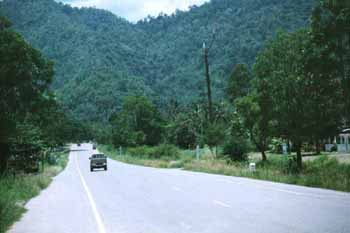
Still fairly flat and straight to begin with, now it was possible to see the Phanom Dongrak mountains (not shown here) in the distance: as far as the horizon to the east and to the west. The only way through is up; and, as is the nature of such roads, it is rarely a direct route. The wide plain before the ascent gave good clear views and the few overtakes were good, clean and fast. Then we hit the steep part.
Ahead were two pickup trucks: the vehicle of choice out of the city (and a lot of them in Bangkok too for that matter). The trucks were moving at a little over 120kph and I paced them for a while, especially as they were travelling close together--I do wish car/truck drivers would not do this: you end up with a convoy and no one can get past, until someone tries and fails. With the bike, though, one does have certain advantages.
When the gradient became really steep I made my first move, just after a bend, where the road opened out to two lanes. The first truck was beginning to fade on the hill and the bike's better power-to-weight ratio gave me the edge. As I passed, I could see that truck drop back, having lost momentum. Then the white truck--lowered suspension and and a rorty exhaust which would obviously save lots of lives. I made the pass after the next right hand bend and then was gone. In my mirrors I could see that Bon was keeping up fairly well. Then we were at the top, with a magnificent view of the farmland to the south behind us, and forests on the hills to the west, with deep gullies on the hills.
This time of year it is normally dry and sere. If you catch the weather forecast on CNN or the BBC, look past the left arm of the presenter when he details events in Australia, Japan and China. Then, when he turns to India and Pakistan, look past his right arm. You may just see Thailand and the Malay peninsula--right now it is obscured by black and gray clouds. I suppose 300,000 cable and satellite subscribers is not enough to get a mention.
The monsoon has arrived early. Instead of a yellowness to the land, the trees are richly green and sprouting. And the green is never uniform, such as you might find in a hardwood forest with mile after mile of the same trees.
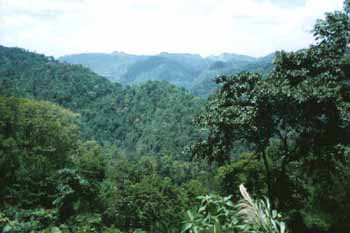
There are supposed to be between 2,000 and 2,500 species of vegetation in the area. Here the darker green softwoods are mixed with the milder palms. Within the green there may be patches of orange or red as some trees flower. My own garden, with an excess of banana trees has a shock of purple-red bougainvillea.
The rains, when they come, usually fall in the evening, although there is no 100% guarantee of this: two weeks ago (when normally April is hot) it rained for three days. Today, it rained this afternoon. Sunday was dry for our ride.
Having reached the top, we are on the edge of what is known as the Korat Plain, where it is often much drier. All along the road there are spots designated as being of interest to tourists, but it is mainly the local people who come out on weekends to eat in the open and then sleep the afternoons. Having come up, the road does not go down but gently rises and falls--short straights, beautiful bends--some quite severe. Third world it may be, but these are no cart tracks. Indeed, in some ways, this type of riding reminds me of parts of Germany, so the BMW sits well. It is not all road, of course, and it is difficult not to look around at the scenery. I am always torn between stopping to touch the country, or riding on through because I am having so much fun.
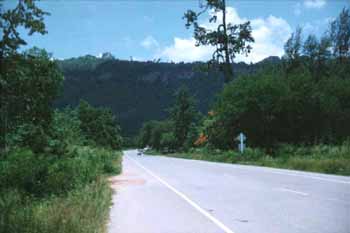
Chokchai (A)
As we got closer to Korat, the road became dual carriageway and the surrounding land was grassy. I knew that at Chokchai there was a huge farm and one of Thailand's major dairy companies--the owner rides horses all day and was featured in the newspapers wearing a M*rlbo*o Man hat. I began to look for the sign for Chokchai: not because we were going there, but because we were to turn in the opposite direction. When the road sign appeared, I made the turn, but within about a kilometre I realised it must have been the wrong Chokchai intersection. Bon told me later that he also realised this but he had the same philosophy: No matter it is a road; we are riding. I also half-hoped that it might come out somewhere.
The road followed a large irrigation canal for its entire length and the country--and the inhabitants--were very agricultural. We passed a lunchtime disco, I kid you not.
Spoons of rice were suspended between plate and mouth as the two bikes went by. Dogs howled or slunk into the bushes. Then we turned round and they did it all again. The road did not go anywhere. It stopped at the entrance to a dam--most dams in Thailand feature parks and you can drive along the dam crest. As dams (obviously) are fairly high, the roads up are often somewhat interesting. I regularly visit a couple on my Sunday rides.
Chokchai (B)
Back at the main road, we turned left and picked up the speed again, soon finding the real turning. I remembered this road having come down from the other direction when I joined a trip up to the Laos border. I only did the first leg, but Peter (BMW K1100RS) from Had Yai, and some Harley Davidson riders from Malaysia went all the way to the Laos border.
I also remembered that the road had some exciting bumps where the surface had subsided. This was clearly signed and the trucks and cars used the hard shoulder and part of the road. That left a clear strip in the centre for Bon and I to zip past almost everything; although we took the inside of a couple of large trucks lumbering up hills. No LEO problem here, of course.
A word about signing in Thailand. Fortunately, most signs--especially on major roads and in the cities are in English as well as Thai. It is only when you want an obscure town, or you are off the beaten track, that signs are in Thai only. If I stop and read slowly, I can normally make out the details. The "bumpy road" sign had the corrugated icon just to make sure.
On some maps I have (issued by a major international petroleum company), the road we were now on is marked as a black dotted line--impassable for vehicles. As we were batting along at something in excess of 100kph, and the road had obviously been laid long enough to degrade (to use a Nato word), I guess they forgot to update that map. No maps (except those issued by the army) are reliable. Some are highly creative.
Chokchai to Lunch
We joined the main road from Bangkok to Korat--the Mittraphap (Peace) Highway some 45 kms west of Korat. Good dual carriageway, it carries heavy traffic from the capital up to Esaan--the north-east. On weekends and public holidays the accident rate is poor, mainly (I suggest) because most accidents involve trucks laden with lots of people: a pickup truck, with a couple of families aboard, that collides with a local bus, is going to spoil your statistics for the month.
Nevertheless, we arrived on this road somewhat early in the day for the thousands who would be heading for Bangkok. The road itself, despite being wide and well-surfaced, curves and twists about in a healthy fashion especially when it goes past another of the reservoirs, between Pak Chong and Si Khiu. I began to enjoy myself so much along here--just enough cars to add spice--that I did not immediately notice that Bon had slipped behind. Once the road flattened out, I slowed and waited for him to catch up. He was about half a kilometre behind as I came upon the turning for Pak Chong so began to pull off. He signalled frantically, so I pulled back on to the highway. He caught me up and shouted: "Fuel"
(He pointed at the tank, so I am sure it was not "Fool". He wouldn't anyway--I am the prof and he is the student: a difference that matters greatly to Thais.)
He had already switched to reserve. He told me earlier that this meant he had another 3 litres (-ish) and so I reckoned on about 60kms or more. We must have entered the stretch where there are no service stations and after about 15 minutes I envisaged a problem. Then, in the distance I saw a service station sign and we were safe. Actually, I was perfectly safe. The first fuel light had only just begun to illuminate. The interesting thing here was that, I filled up and took on 12.3 litres, while Bon (on a 400cc motorcycle) took on 13 litres for exactly the same distance.
Having lived here for a while, there are certain Thai-like attributes that develop. One of these is a need for food. Regular food. Normal, healthy Thais have to eat every hour, and so there are food stalls everywhere. The gasoline station had five or six and they were all fairly busy. And I was hungry. Bon suggested, however, that we move on a bit further as the turning for the park at Khao Yai was only a little further and, he said, "There are lots of restaurants down there."
He led. Within ten minutes we were on a really quiet road with green hills all around. We passed a small herd of elephants--domesticated and for tourists to ride on--at the side of the road and then stopped just shy of the park entrance. We had passed several restaurants and all there was here was barbecued chicken and somtam. This is a spicy salad, with a base of green pappaya and a whole load of other mysterious ingredients, perhaps including wing of bat and leg of toad--a westerners nightmare. I eat this closer to home, with careful monitoring of what goes in. Here in the wilds, discretion was the better part of, etc..
We went back a couple of kilometres and pulled into a quiet, open air restaurant at the foot of the hills, where we parked the bikes under the shade of some trees and went to eat rice.
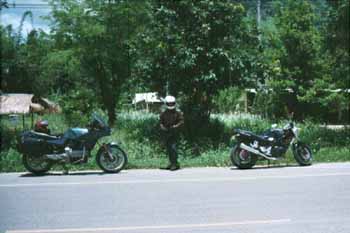
Lunch and a Post-prandial Photo session
The restaurant we ate in was fairly typical: open air, roof thatched with palm leaves and a laid back staff. The owner read the newspaper while we ate and watched the few vehicles pass. Over lunch Bon and I chatted and I asked him about his riding experiences. He had ridden smaller bikes when younger, as almost all Thais do--the licence seems optional. Later he had passed a test and gone on to a larger bike although he had begun to find 400cc restricting. "This is the first time I have gone for a long ride," he said.
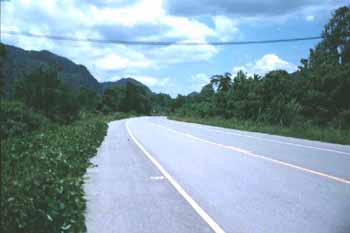
I asked him about his trips from the south of Thailand to Bangkok, and from Bangkok to Khon Kaen in the north-east and he thought of them as trips: this was a ride. I also asked him about rider training. None. He had to take a theory test, and a colour-blindness test; and then all that was required was that he circulated in the car park without falling off. This does not surprise me. Bon has obvious self-control when he is riding, but this is lacking in many drivers and riders here.
After eating, we decided to head back down the road to take some photographs before continuing into the park. Unfortunately, the elephants had gone to lunch along with their mahouts--the handlers--so the first subject was missing. No matter, Thailand has lots of elephants.
Into the Park and Up the Hill
I took some images of the road and surroundings, and one or two of the bikes. The we drifted up the hill, stopped a couple more times and headed for the park gates. "I will go up and pay for us both," said Bon. "Stop on the side. And keep your helmet closed." This was to cover the possibility of two-tier pricing that sometimes occurs here: Thais get a discount because they pay taxes locally. So do I. I avoid places where this occurs.
This National park had no such policy, and for ten baht each (about US 30˘) we entered. I presume that the fee was not for items such as road maintenance. Almost immediately, it was obvious that a slower pace than before was required. There were signs at regular intervals asking motorists to stick to 60kph. You could not really go much faster. But then again, you would not want to.
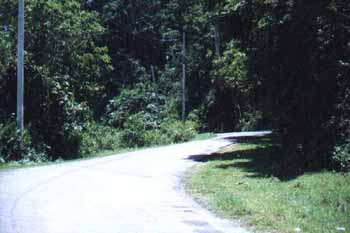
Entering the park was like entering some dark, green grotto. Even as the road curved up the hill--to the left, the right, then sharp left almost turning back on itself--the overhanging foliage cut out the sun and much direct light. I became aware of how unusually cool it was here and a couple of lines from "The Garden," by Andrew Marvell came into my head:
Annihilating all that's made
To a green thought in a green shade.
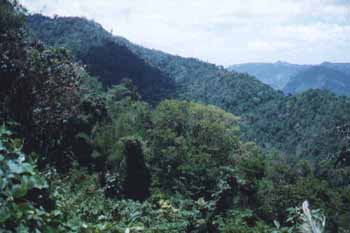
Here however, the verb was too strong (can you tell I am an English teacher?) and concentrating on riding the bike needed some thought. Halfway up the mountain, the road and trees opened out a little and there was a patch of open grass: just enough for a couple of bikes.
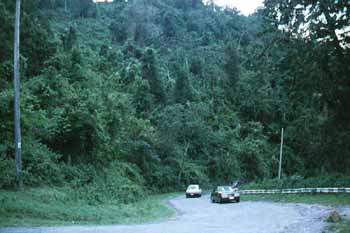
Bon and I stopped and I took the camera out of the case. I had to walk right to the edge of the raod before I could see over the bushes into the valleys beyond.
I have seen this from a plane overhead several times, but standing--and riding--on the same level is wonderful.
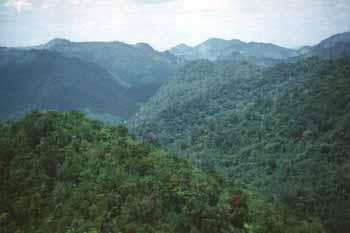
Getting off the patch of grass was not so easy and I slipped back a bit as the rear tyre struggled for grip. A bit of determination and a few more revs did the trick and we carried on up. In parts here, it reminded me of the bordxer road between Satun and Malyasia in the south of Thailand--quiet, cool and green--although the gradients here were far more severe.
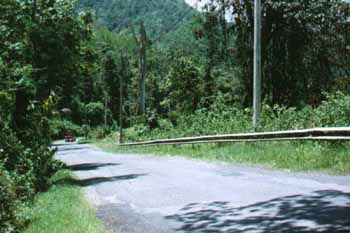
The road levelled out after a couple of kilometres and the edges were wide and flat. We came upon the first warning sign--Elephants Crossing. I do not wish to seem blasé about this, but this, and similar elephant warnings are quite common here; and an unlit elephant at night is a serious road hazard.
The Top and Down Again The top had several areas for "scenic viewing" and there were a couple of dozen cars parked. We passed slowly as one or two reversed in and out. A few hundred metres down the road was the first of the unusual signs. I had heard of these, but never seen anything like this before. The first was the warning (in English): Beware / Cobra Crossing. The Thai words simply say "Cobra Zone." How could one resist not stopping to photograph this?
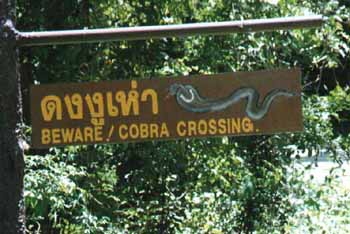
Snakes are fairly common in Thailand--I have had some in the garden of my house--and on my Sunday rides into Kanchanburi, it is not unusual to see one basking in the sunshine, laying on the road. The remarkable thing is the distance at which a snake can tell that something is approaching, and the speed at which it gets out of the way. Generally, even the snakes in the garden, want nothing to do with people and try to remove themselves. They turn if threatened or attacked. Of course, if you accidentally tread on one, that could be construed as an attack. I placed my feet carefully as I took the pictures.
As a side note, the second Bangkok international airport, which has been on again, off again for several years, although may have now been started, is at a place called "Cobra Swamp." I expect it will be drained before the first flights.
Back on the bikes we went another couple of hundred metres and found the second road sign: Beware / Tiger Zone. Again, the Thai words are slightly different and could be translated as "Area where tigers pass." Neither Thai sign had the word for Danger, but I guess that could be construed from the rest of the content.

Bon and I stopped the bikes at the side of the road and I took a couple of shots. I am told that the best time to see tigers is from June to October but I was kind of hoping that there would be none around this Sunday. In Britain, you are not allowed into any of the safari parks on two wheels, and here we were, with no restriction, truly in the wild. Not that we could see more than two metres into the dense forest, but I did suggest to Bon that, if we were standing or even riding through the area and a tiger was interested, we were dead meat, so to speak.
The road began its downward path now but this was not as pronounced as the rise had been. The surface was still fairly poor. Some distance from the summit the trees stopped and we were on a grassy plain. The road meandered through this area--the trees were away in the distance--for about 5kms until the trees closed in again. We had to stop at an area where there were park offices as there were a couple of signposts. The map was not much help but one road was signed for Bangkok, and while we were debating, three coaches belonging to the National Lottery went down that lane. The final decision was made by Bon who said (and I quote), "I think a girl on one of the coaches smiled at me."
This was a mistake. We should either have gone before the coaches or waited for half an hour. Once we had caught them up, overtaking proved to be far more difficult than I imagined. The straight sections were not too badly rutted, but the corners were. Some had no surface at all. Coming up behind the first coach, I had to slow each time the driver went round a bend, and then he would accelerate while I was still negotiating the corner. As this was mostly downhill, the coach got away from me each time and I only caught up on the approach to the next bend.
Once or twice I made a feint, but the coach, being much wider, left too little road width for what I considered prudent. Patience was needed. As I always ride with the headlight on, I was sure that the driver was by now aware of my presence. On one stretch, he gave me a lot more room and I was through with a big wave. Some drivers here are less accommodating.
Having passed the first coach, the other two soon realised I was there and had the passing capacity and they too were not at all obstructuive. Bon too had little trouble passing and we were soon leaving the three vehicles behind. Progress was still not that good as sections of the road were so poor.
Coming out of the park, the road surface improved immediately and the trees were left behind. I put the speed up to about 100kph and eased back into a better rhythm before coming out at a fairly substantial town. We stopped after the intersection and had a chat about the next stage of the day.
From the Countryside to The City and Home
My instincts, the map and my navigation all told me that we had come out onto highway 33, the same road that we crossed early in the morning and that turning right would bring us directly to Nakhon Nayok (NN). I was wrong. I think the map is too. But that would be no surprise.
Turning right indicated NN but the road was not direct. We ended up n Pichit, several kilometres south of the park, and then turned north west for NN where we were able to join the 33. To begin with this is a nasty, twisty litle road with a bumpy road surface and heavy traffic. There was also a fearsome cross-wind. It confused Bon so much that he thought the bike's misbehaviour was caused by low fuel.
A few kilometres out of NN, the road opened out into a smooth dual carriageway, just finished, or in parts almost complete. Speeds here increased substantially and felt safer than the 60kph of the park. We had crossed into the province of Saraburi, and there was obviously more road money available here. Eventually, the 33 crosses the main northern highway and we switched to this road for the general direction of home.
We could not use the main highway--on some roads in Thailand, bikes are banned and this was one of them. Instead we used the two-lane service road that borders both sides of the highway. It was interesting to watch the cars and buses heading south a few metres from us, mainly in the outside lane and, as a result, travelling slower than us, even though the surface was pretty bumpy in places.
We would have had to have come off the main road anyway as I had planned a route which meant a switch to a cross-country road. I knew there was going to be a problem as I had never actually managed to find this road. Going north was always ok, but heading home, I had missed the turning three times thus far. This time I thought I had done it again. A few kilometres further south, I saw a sign for the outer ring road and a place name I knew: Bang Bua Tong. That was close to home.
Off the service road and across the bridge, we were on the right track. Traffic on this route was quite heavy. A couple of years ago when the road was new, no one knew about it and the huge distance (and time) it cut off a journey to the north if you lived on the west side of Bangkok. Now, all the world wants to play.
I am not sure if he was tired, or if the traffic got the better of him, or even if the bike was playing up, but Bon began to hang back and I slowed down a number of times to let him catch up. He was with me, however, when we got to the end of that road and navigated the three-way intersection that brought us onto Highway 340 for the last lap past Nonthaburi and back to the western edges of Bangkok.
The road here is still under construction in places, so bits need to be taken with care; but south of Nonthaburi, the road has opened up to a four-lanes in both directions plus two-lane roads on either side. Some drivers have still not got used to the extra two lanes and both the outside lane and the inner lane are almost free of cars. Bon and I made full use of these to make progress. When the 340 crosses the Nakhon Chaisri road, we took the overpass and turned for home. I waited on the far side for Bon to come past and then he turned off at Putthamonthon route 2, while I continued home to route 3 a further 5 kilometres out of Bangkok.
Conclusions? Get back out there ASAP.
İGraham K Rogers
Bangkok
April 1999
For further information, e-mail to Graham K. Rogers.